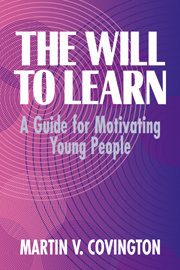Book contents
- Frontmatter
- Contents
- 1 The Future and Its Discontents
- 2 Motives as Emotions
- 3 Motives as Thoughts
- 4 Self-Worth and the Fear of Failure
- 5 The Competitive Learning Game
- 6 Motivational Equity and the Will to Learn
- 7 Strategic Thinking and the Will to Learn
- 8 An Immodest Proposal
- 9 Obstacles to Change: The Myths of Competition
- Epilogue
- Appendixes
- References
- Author Index
- Subject Index
9 - Obstacles to Change: The Myths of Competition
Published online by Cambridge University Press: 31 January 2011
- Frontmatter
- Contents
- 1 The Future and Its Discontents
- 2 Motives as Emotions
- 3 Motives as Thoughts
- 4 Self-Worth and the Fear of Failure
- 5 The Competitive Learning Game
- 6 Motivational Equity and the Will to Learn
- 7 Strategic Thinking and the Will to Learn
- 8 An Immodest Proposal
- 9 Obstacles to Change: The Myths of Competition
- Epilogue
- Appendixes
- References
- Author Index
- Subject Index
Summary
Competition prepares one for life. But what kind of life?
Marie HartToday when parents are asked about educational goals, they typically give high ratings to promoting self-esteem and the will to learn, right along with competency in reading, writing, and mathematics (Reasoner, 1986). This is surprising for the fact that only a few decades ago reading and mathematics dominated these polls, with esteem and motivational goals trailing badly. Perhaps even more remarkable is the fact that these shifts in priority hold across a broad socioeconomic spectrum. Both working-class parents as well as those in the professions endorse self-worth values. It seems that the lay public has come to intuit what we have demonstrated empirically, that feelings of self-worth stand at the center of the achievement process, and also that competency and feelings of worthiness go hand-in-hand.
These ratings are also remarkable for what they reveal about public misunderstandings of the instructional process. Other expectations are also at work, too, behind the scenes – factors that threaten the delicate balance between competency and confidence. First, as we know, there is the widely shared belief in our society that schooling should be efficient. Second, many parents and teachers believe that arranging incentives around competition is the best way to ensure efficiency as well as creativity (Collins, 1975; Elleson, 1983; Grenis, 1975). This latter belief is so pervasive that, as will be recalled, George Leonard (1968) charged that competition is being taught in schools as an end in itself.
- Type
- Chapter
- Information
- The Will to LearnA Guide for Motivating Young People, pp. 233 - 256Publisher: Cambridge University PressPrint publication year: 1997



